“Theatre Spaces 1920-2020” by Iain Mackintosh
Iain Mackintosh: “Theatre Spaces 1920-2020 – Finding the Fun in Functionalism”
Methuen Drama (2023) – 242 pages
Reviewed by Dr Simon Jenner
Before the 1930s, books on architecture from Vitruvius onwards might have had many virtues but being interesting to the lay reader was not one of them. All that changed from Nikolaus Pevsner to Owen Hatherley, and further, books on theatre architecture have emerged as one of those topics engaging anyone who visits theatres, opera houses, or community centres.
There is sometimes initial outrage, say at the origami-topping Sydney Opera House. Then, miraculously, the carbuncles become national treasures. Annoying sometimes, but our annoying.
Even amongst these though, this handsome large format paperback – lavishly illustrated – by Methuen Drama, is unique. Taking us from modernism to lockdown, Mackintosh neatly cusps a century and suggests we are at a new juncture.
Having a practising theatre-space architect responsible for the interiors – even design – of major buildings is one thing: it’s quite another to even have him write such a vivid hybrid manifesto/memoir, then hailed in a blurb quote (by architect Steve Tomkins): this “memoir” is “like the man himself…. erudite, trenchant occasionally infuriating….”
Mackintosh summarizes a mini-autobiography too; intriguingly fifth in sequence of seven stepped arguments that frame the book.
First – do we start in 1920 or 1876?
Denys Lasdun versus … Richard Wagner
Chief among those might be the ghost of Lasdun. Here he’s pitted rather unusually against the shade of Wagner; it’s an unequal contest of gods, and we’re treated to a view from the gods.
Immediately we’re pitched in the seven-stage introduction, where the starting date for modern theatre architecture could be 1876. Wagner’s Bayreuth theatre was revolutionary, the composer demanding and obtaining a fan-shape, later apostrophised as the only shape by George C Izenour in his monumental Theatre Design of 1977. That too becomes a rigidity that Mackintosh’s book addresses.
But apart from a Worms People Theatre on the Upper Rhine (bombed in 1945) no-one took up Wagner’s radical design until 1920. Hence the book’s start-date. Wagner, not Bauhaus, showed the way.
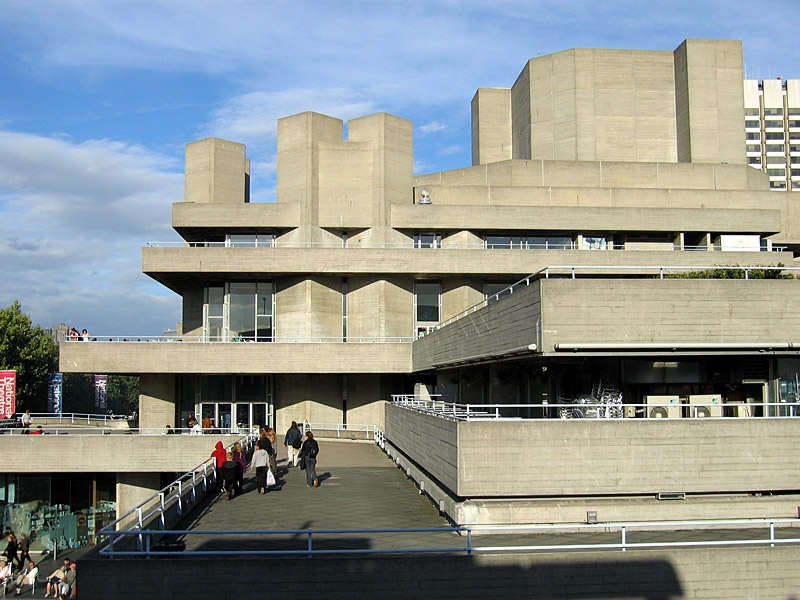
The National Theatre.
Creative commons license.
Second – the National Theatre as a reference point
Mackintosh now brings in the unfortunate Lasdun. But what in reality happened both to the National and Barbican Theatres was a delay from 1960s optimism and funding to an implementation in an age of austerity: from (particularly with the National) an age of triumphant brutalism to an age that wanted something more than poured concrete to determine its seating, acoustics and theatre spaces. Relatively cheap to prepare, concrete has not helped any of this.
Though Richard Eyre was on the NT committee he later recalled in his book National Service how he tried to lure Albert Finney back to the National from his days when it was at the Old Vic. Finney invoked Peter Brook’s comment (in The Empty Space) that a theatre space was a musical instrument on which an actor plays. Finney’s retort: ”Yes, and who would make a violin out of fucking concrete?” might stand as many actors’ epigraph. As for the National’s artistic director Richard Eyre, he said about the largest space, the Olivier:
“It’s a hard stage on which to focus attention, hard to animate. Its monumental scale militates against intimacy and its enormous volume gives rise to lamentable acoustics.”
But to lay that wholly at the door of Lasdun and brutalism would be brutally unfair. Acoustic problems, huge audiences and inaudible distances were a thing of the 2000-plus Victorian and Edwardian spaces, far more than today, as we learn.

The National Theatre.
Creative commons license.
Third – the different sorts of theatres contrasted
Mackintosh in his third point addresses size from the 200-400 space he often deals with in the book (the Orange Tree in Richmond for instance) to the re-purposing of old theatres. Peter Brook’s Bouffes du Nord was an old 1876 theatre that, left with its stone undressed in fact invites both epic and intimate, as unrestored. By contrast, with the Munich Opera House, the reverse is true. A wonderful 1817 building had been replaced by a so-so 1825 one blown to bits in 1945. It was universally agreed to rebuild the 1817 model, delicately reconsidered with a horseshoe but essentially the same. “Come, gentle bombs…”
Fourth – the audience listens
Not often considered by modernist architects is the reciprocity of audience, the reconsidering of space for an audience brought up in the age of BBC Radio where many theatre writers started under John Tydeman. The balance of listening versus spectacle – Mackintosh uses it in its more radical, non-pejorative sense – is as he says a delicate balance. He invokes the opening Chorus of Henry V, the audience’s “imaginary forces”.
Fifth – the author’s viewpoint
It’s only now that we arrive at Mackintosh’s own remarkable beginnings. After National service and Oxford where he studied PPE, he found himself in 1961 designing an opera – Britten’s The Turn of the Screw (1954), its second production anywhere. The librettist and designer of the original, Myfanwy Piper and John Piper respectively, turned up twice. Mackintosh had just founded Prospect Theatre Company, more as administrator without having studied drama.
We are treated to 13 years of productions in brief: Mackintosh’s happy relationship with the British Council and miserable one with the Arts Council who demanded that Prospect go to places where it would founder because – crucially – the space was wrong.
Though continuing with Prospect until funding withdrawal bankrupted it in 1981, from 1973 Mackintosh was invited to embark on a second career for which he had just as little qualification. “Ignorance is a bloom” he quips. From being invited to an Edinburgh consultancy Mackintosh swiftly moved to outlining the entire Cottesloe, a project (as we discover) taken from Lasdun who had only envisaged it as a studio basement theatre. Mackintosh changed all that.
Sixth – clarifying capacities of older theatres
This is where Max Beerbohm comes in. Banned from expensive press tickets at the Garrick for being over-critical, he watched from cheap seats. The range was far wider than now, with seats or bench varied accordingly. He apologised to actor-manager Arthur Bourchier because he now understood that Bourchier’s booming voice was the only one to reach the back of the pit.
Theatre capacities have for the most part reduced in size since this period. Edinburgh’s Lyceum for instance built in 1883 for 2,300 was still holding 1,300 when Prospect went there in 1967-8 but it now only holds 658.
The danger in homogenizing seats and prices, comparatively speaking, is that they are all now out of the reach of anyone but the moderately-waged upwards.
Mackintosh again insists that we understand the way these large projects unfolded: that by the time national projects were realized, we had moved into an age of austerity and pessimism from a time of optimistic plenty. He quotes Michael Elliott from a 1973 Radio Three broadcast, reflecting on his own part in appointing Lasdun; in fact addressing what was wanted.
“Isn’t it time we stopped lumbering our grandchildren with our mistakes? Don’t we need something different, less expressive of civic or national pride … something less permanent? In future should we try to retain a certain lightness and sense of improvisation…? In short should we stop building for posterity?”
Stephen Joseph went further in his philosophy of theatre-in-the round, suggesting that all new theatres should have a time-bomb in the basement, set for 15 years.
Seventh – Unremarkable interiors
This is where Mackintosh takes on the absurd (until recently) sidelining of the great theatre interior designer Frank Matcham. I have to declare an interest since I’ve chaired a campaign to save one of these (the Brighton Hippodrome). Mackintosh points up the unremarkable exteriors versus the brilliance within. In fact, the theatre I have cited was originally an ice rink then circus, so Matcham sometimes was not responsible; but Mackintosh’s point is well made. By contrast, John Betjeman loved the NT’s exterior “which is what counts” he added blandly, wholly missing the point.
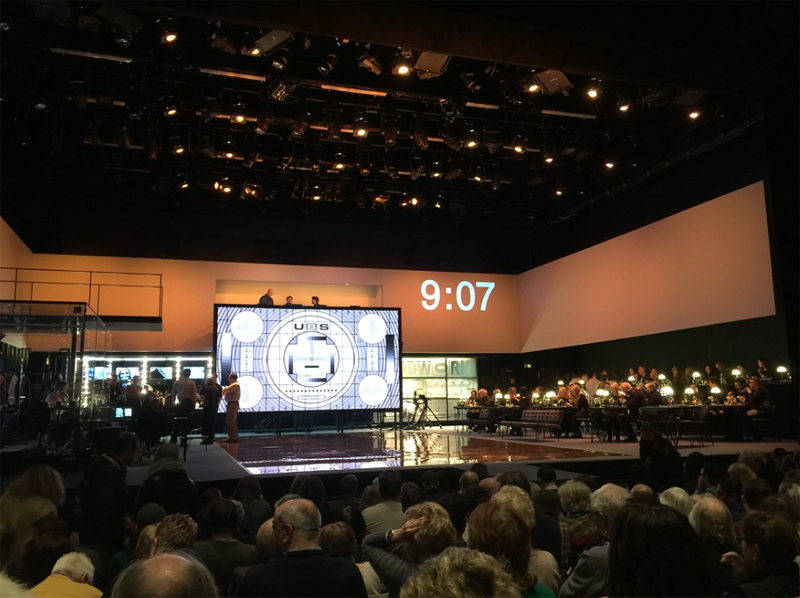
Lyttelton Theatre.
Finally – the elephants in the room
Mackintosh addresses this head on:
“Why cast the Olivier and the Lyttleton as the elephants in the room? Their bulk and lack of colour are certainly part of the problem. But at the centre was Lasdun’s narrow definition of functionalism. Both the architects of theatre buildings and those who create performances therein need to check what is needed for live theatre to function well; how to achieve a balance between looking and listening, and above all how to create theatre spaces that delight an audience and prompt their participation in performance.”
Having also divided his book into four Acts, the following chapters expand Mackintosh’s arguments. Richard Wagner, Adolphe Appia and the spreading of the fan segues into:
Act II 1920—76 the march of modernism
This is where Mackintosh comes in, at the end of this Act (he is more involved in the third and longest). He begins with a chapter on the 1930s Cambridge Festival, a visionary idea with Greek overtones (the poet/playwright Joseph Macleod was much involved here, though he is not referenced). We cover ‘Guthrie’s thrust stages’, ‘Germany’s building boom and Anglo-American Shakespeare’ which discusses American influences 1948-97, in particular the inception of Shakespeare’s Globe in 1969, a project he discussed then with Sam Wanamaker and the horse-trading (Wanamaker wanted more ingressi, entrance/exit-points, the scholars and architects didn’t; but they won over stalls seating to the front). And we arrive at those two Elephants and the Barbican.
Mackintosh is trenchant and sometimes funny in expanding on his introduction. Justifications and counter-justifications (Lasdun’s included) mark the minutiae of scholarship Mackintosh never loses sight of, even if he finds Lasdun wanting and occasionally inspired (responding to a late brief about a café no-one envisaged; planners thought everyone could decamp to the RFH for a bite), though he resisted the idea of a bookshop.
Culturally though Lasdun thought the buildings were his; actors might use them. Actors and directors felt now the building belonged to them, thanks very much.
The Barbican’s inception was even longer, from 1958-82, better acoustically, with John Bury’s help and – like the National later on – with input from Peter Hall. Ultimately, Mackintosh deems that the Barbican succeeds as a theatre space but not as a building (with difficult subterranean public spaces and depressing underground dressing rooms). Hence the National succeeds more as a building everywhere but where it matters in the two bigger theatre spaces.
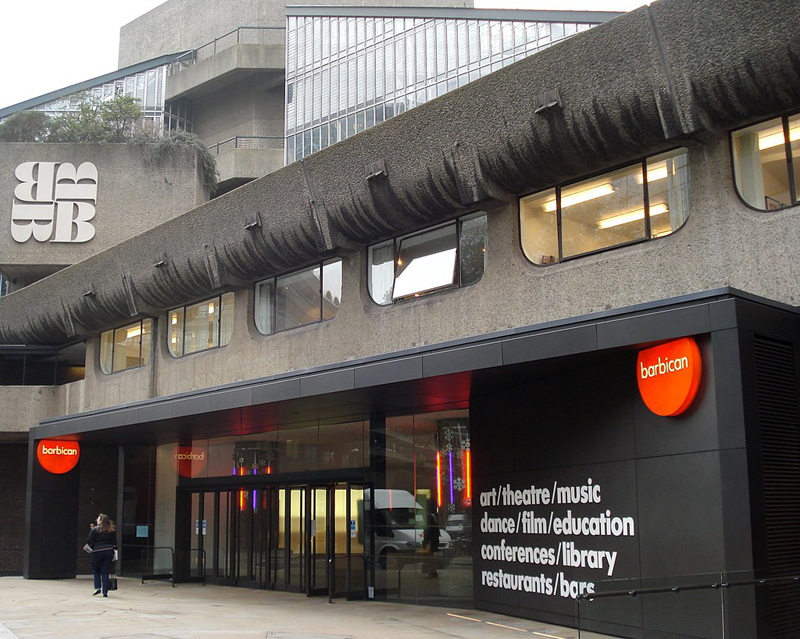
Barbican Theatre.
Act Three 1976-2020: the past informs the present
Mackintosh starts with his Chapter 7 (The Cottesloe and other courtyards) detailing how he was pulled into his first major design, coming up with the 1973 genesis, after Lasdun was directed to leave the brick outline of a third theatre. John Bury took over, repositioned it and Mackintosh was brought in. Mackintosh asked to borrow the model for the weekend and came up with the plan. Ultimately it was a design on ‘found space’. But the courtyard theatre, borrowing from early (and eighteenth-century) model began to find its time.
In only one thing Mackintosh didn’t get his way. He preferred colour (and got it elsewhere) but was overruled. Sir John Gielgud summed that up: “The theatres are perfectly terrible. The only one that is any good is the Cottesloe and that is painted black like a coffin.”
There is no need to go into the colour of Lasdun’s face. But Mackintosh’s thoughts on the 2015 redesign of the now Dorfman are instructive. He applauded the mechanical device to create raked or shallow seating, but the original cheap standing room vanished.
One postlude remains. The modest cost of the National (£16 million, £85m today) beaten only by the Chichester Festival (winning less praise), was dwarfed by refurbishments from 1997 and 2016 costing £190 million. Even scaling up the original price to £85 million suggests something drastically wrong, mainly with intractable concrete.
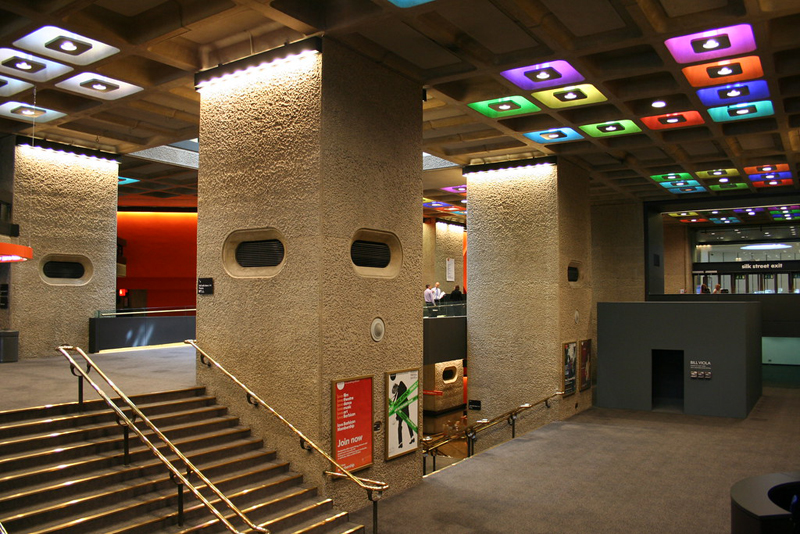
Barbican Theatre.
The same applied to the NYC Polonsky Theatre, Bracknell, Calgary, Salford and a separate praise – Mackintosh is very good at praising other architects – on Tim Foster who specialised in school theatres. Thus Inigo Jones informs the Vanbrugh at RADA, and the original concepts in the Wanamaker Playhouse get aired, not least because Mackintosh and others were convinced Jones bequeathed a drawing – now attributed to his assistant John Webb imitating him. Jones, his geometrical designs and overlays informed Mackintosh and revivified theatre space thinking.
The Sage Gateshead, the Swan, Mackintosh’s favourite, and later on the Orange Tree (1991) are considered along with their genesis; and writer/directors like Alan Ayckbourn reversing their judgement that they could not work in such a small acting space.
There is a chapter too on Peter Brook’s inspiration, the use of found space. There is another chapter on regenerating older theatres and campaigns to save older theatres – the Almeida and Lawrence Batley (Huddersfield) are praised, the Donmar less so. And another on regenerating old designs in new-build theatres in Edinburgh and Florida. And the Lyric, Hammersmith and Dunfermline Festival ‘one of the best theatres in the world’.
Mackintosh’s crowning achievement latterly is the new Glyndebourne opera house, where canny connivance by George Christie to limit the width of the auditorium was vindicated. Michael Hopkins was lead architect, and Mackintosh worked with him to create the galleried horseshoe, credited to Mackintosh.
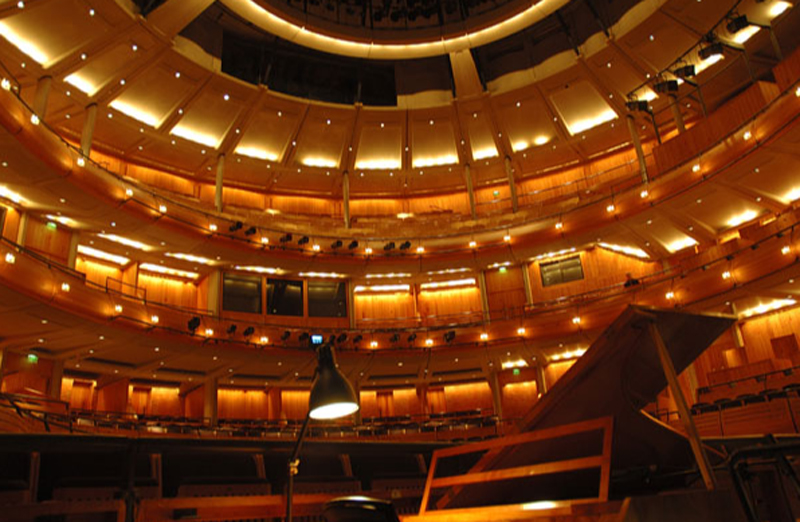
Glyndebourne.
Mackintosh rarely stints on quoting praise, like Bernard Levin on this achievement in 1994. There is discussion of e.g. Dallas Opera, another project. This through-aesthetic also informs other smaller festivals, warmly judged. Of four of those New Garsington, with the nominally dismantlable theatre, enjoys personal input. Mackintosh recommended Robin Snell, Glyndebourne’s project architect.
Taking in the initiatives of other continents (two impressive sections), Mackintosh ranges far across new ventures like open-air theatres (Regent’s Park his benchmark) before addressing:
Act IV: 2021: The future
This is brief. Mackintosh is well aware that nothing dates like the future. Already ‘Unforeseen consequences of seventeenth-century plagues’ does allow Mackintosh some ‘central themes restated’. Some, like the Puritan shutdown from which it took a century to really recover now seem prematurely alarmist; but the ‘arrival of the talkies’ has by contrast had a century to bed in. And naturally cinema palaces repurpose as theatres.
Other modes of course have evolved in the opposite direction. NT Live and its imitators had from 2009 to embed, but Covid brought home transmission and the birth of National Theatre Live at Home. Mackintosh praises, but issues a warning too. There is brief coverage of virtual theatre, survival of art cinemas and the decline of touring. And the persistence of pantomime led by the shade of Ken Dodd.
It is simply an essential book: authoritative, original, comprehensive, compulsively readable, beautifully designed. You can dip in and out; even if you just visit one of these venues casually, you will find this engrossing. Summarising, and quoting his own praise, Mackintosh concludes:
“Lastly a good thing is that the modernism prevalent in the mid-twentieth century has turned out to be a blip … it had been engendered by an incomplete functionalist philosophy which neglected the role of audience.”
Lasdun, lie still!









